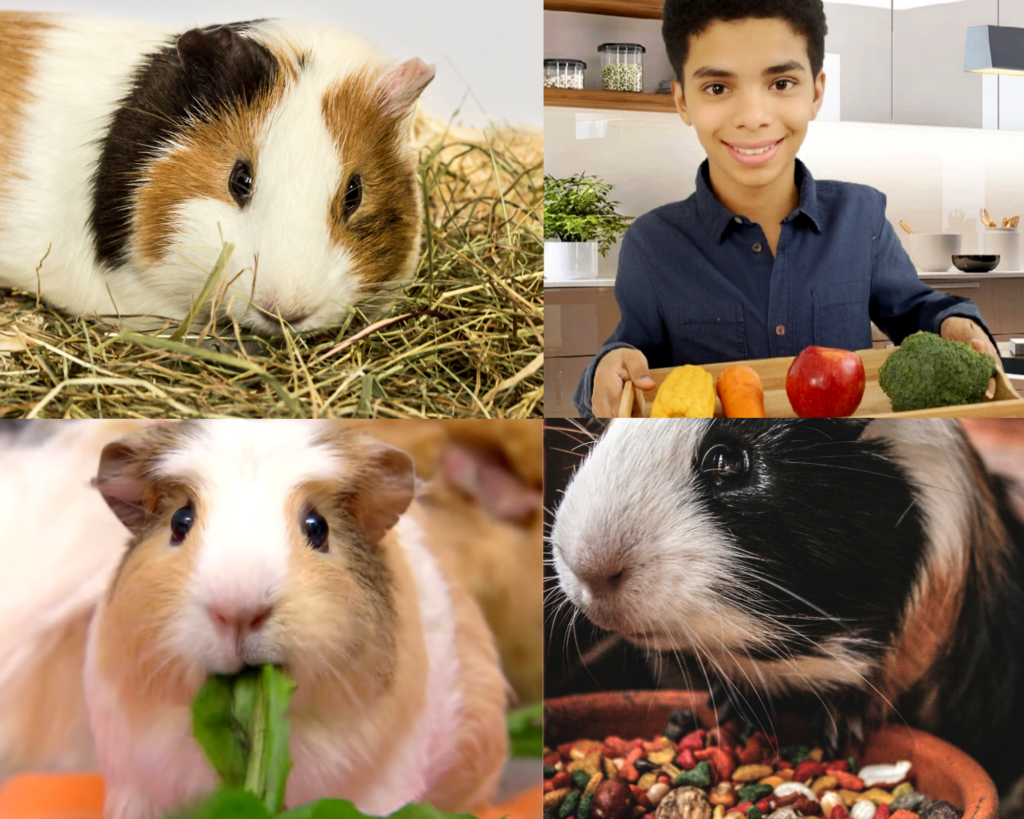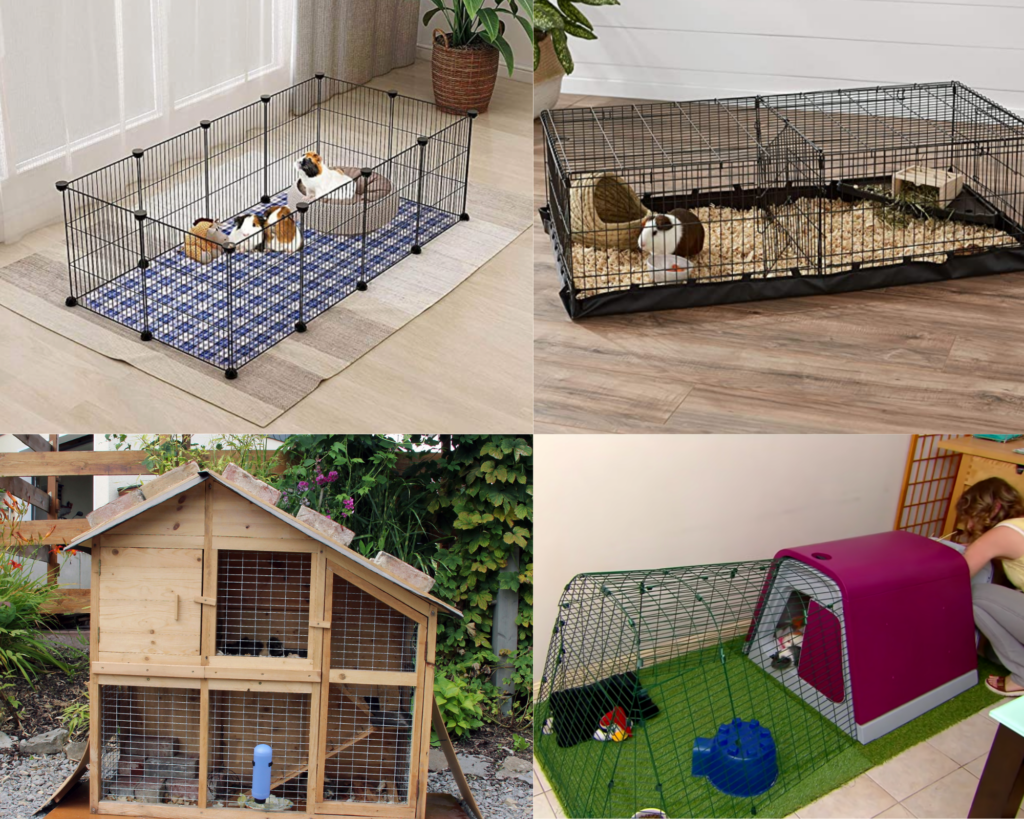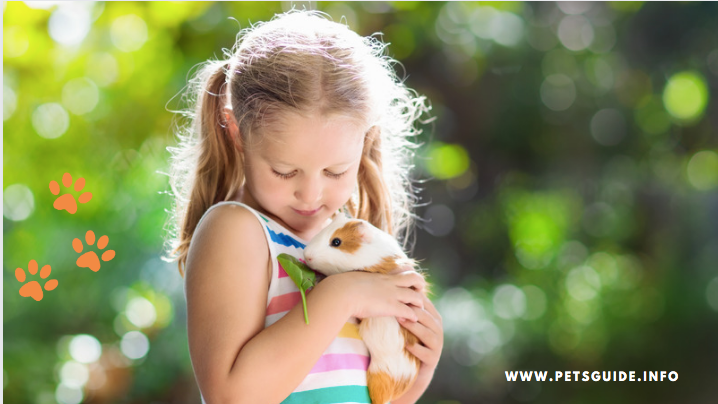Animals
How To Care for Your Pet Guinea Pig – A Complete Guide 2022
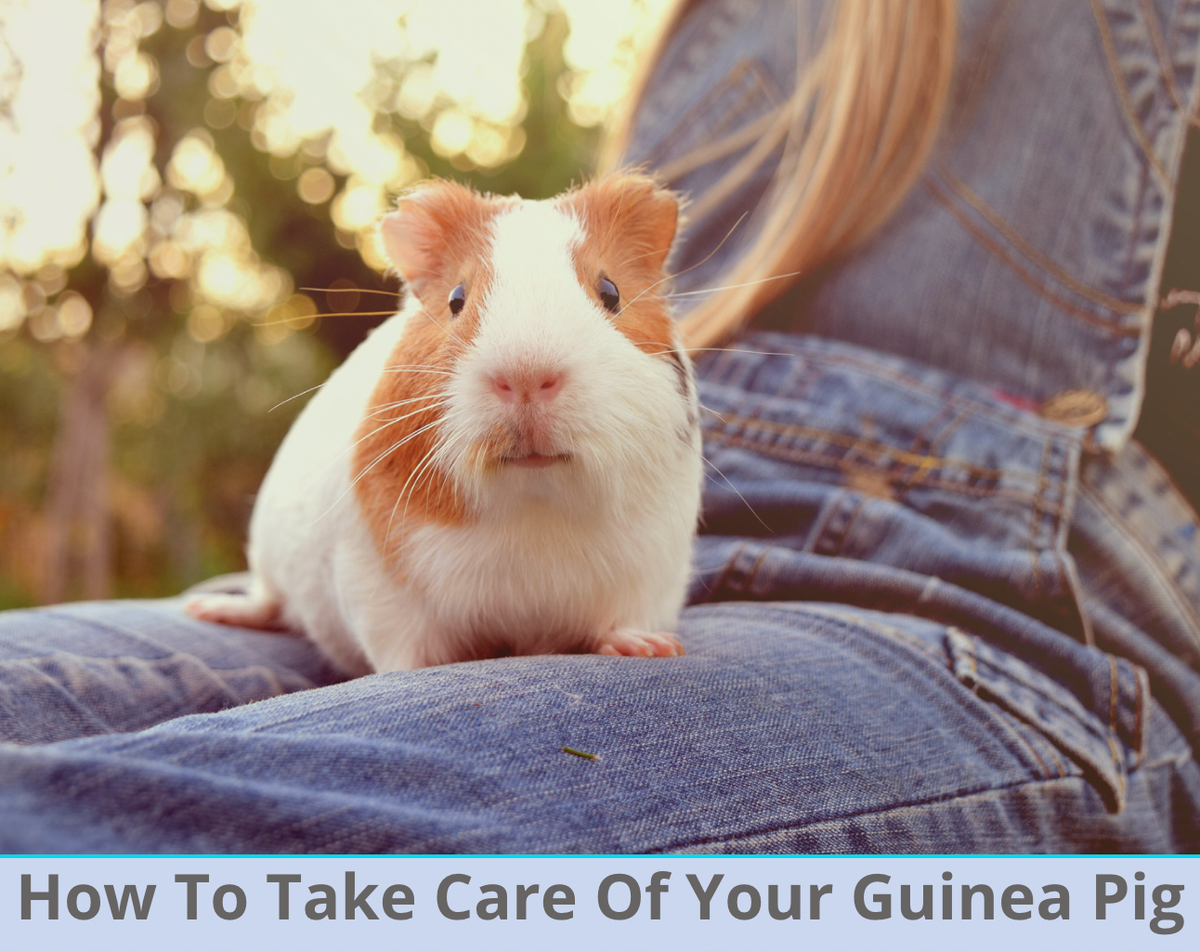
Everything You Need to Know on How To Care for Your Pet Guinea Pig
Caring for guinea pigs or cavies as they are known, isn’t hard at all. In fact, they are one of the most fun and rewarding pets you can own. They are docile, friendly and are the sweetest little creatures.
Since they are herd animals, guinea pigs enjoy being around other guinea pigs. They do very well as a pair of the same gender unless you are breeding them of course.
Guinea pigs love to have human company too and become very attached to you as they are sociable animals.
So now you’ve found the best pet in the world! How do you take care of a guinea pig?
What to feed your guinea pig?
Guinea pigs are herbivores, and they should be fed a diet that consists of hay, vegetables, fruit, pellets and water.
Hay is the most important part of their diet as it helps to keep their teeth from becoming overgrown. It also provides them with the fibre that they need to stay healthy. They forage around eating food all day long.
A Guinea Pig’s diet consists of the following foods:
- Hay 70-80%
- veggies & apple 1/2 cup
- kale branch x1
- Pellets that are reinforced with vitamin c and iron
- fresh water daily
More About Guinea Pig Diet
One of the best ways to make your guinea pig happy and healthy is by changing the diet. Fresh vegetables are good for your guinea pig, but you should be careful not to overfeed your pet.
Fresh vegetables do not contain the same amount of nutrient density as pellets.
However, many guinea pigs will start liking vegetables over pellets in the beginning. Try to introduce new vegetables gradually to avoid introducing a new ingredient at once.
Vitamin C is an important vitamin for guinea pigs, as it helps maintain healthy body cells.
Unfortunately, guinea pigs do not produce this vitamin, so it must be obtained from their diet. If they do not get enough vitamin C in their diet, they can suffer from various health problems, such as poor bone density, teeth deformity, and even decreased appetite.
Fortunately, vitamin C can be found in many vegetables, including spinach, broccoli, bell peppers, and tomatoes. Some guinea pig specific pellets are also available that contain high levels of vitamin C.
Another good vegetable for your pet Guinea Pig is raw beetroot. It contains little or no oxalates and contains a good amount of calcium.
Avoid feeding your pet too much cabbage, which can cause bloating and gas. Sprouts contain phosphorus and oxalate acid and can cause stones. Also, squash is fine to give your guinea pig once or twice a week.
NOTE – Double the amount for 2 guinea pigs.
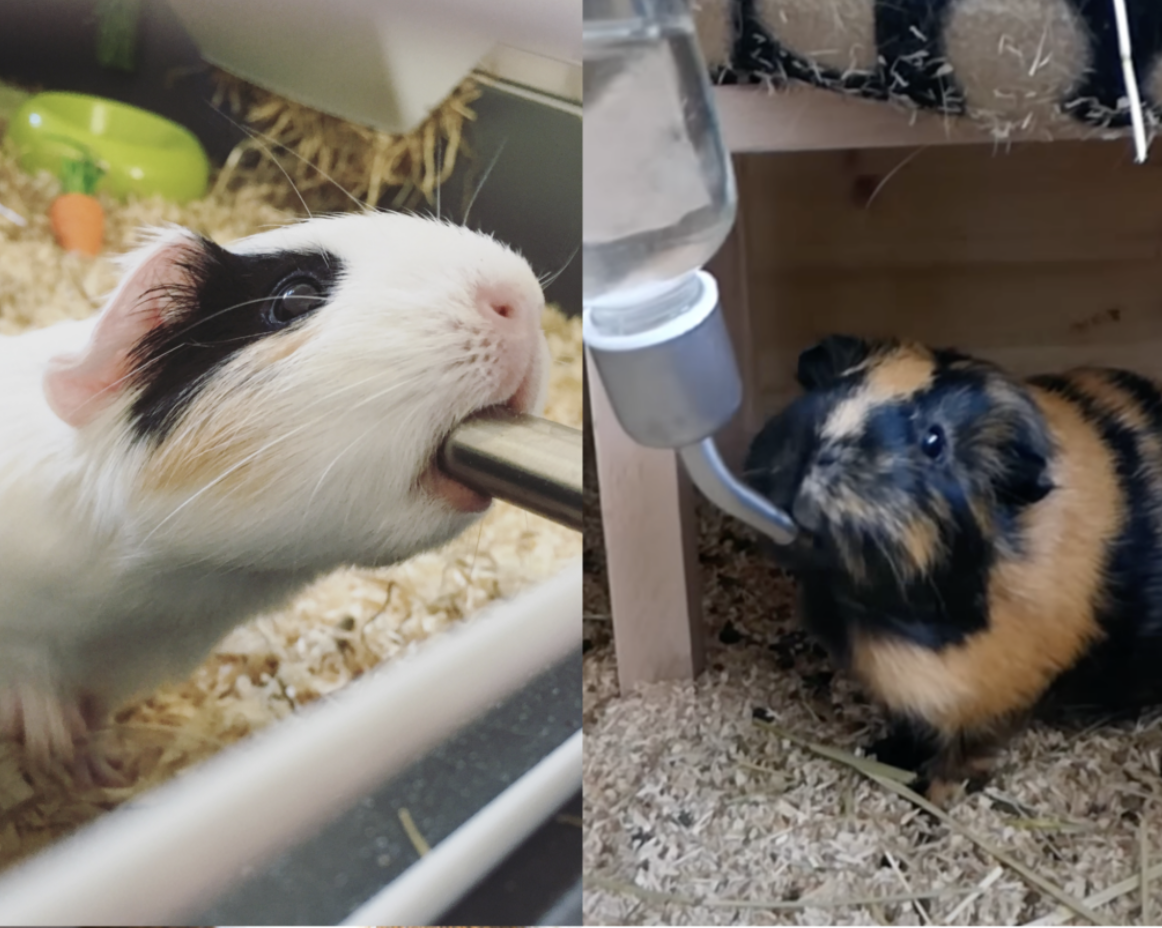
TOP TIP – Buying a water bottle instead of having a bowl of water will be especially helpful for your guinea pig. The reason why a water bottle is a better option is so the water stays clean and your guinea pig is not stepping in or pooping in the water dish.
Housing for your Guinea Pig
Household supplies
Some of the household supplies your pet Guinea Pig needs are simple toys. Some are made of treats, such as ping-pong balls. Always wash these toys thoroughly before using them, though.
Your pet will love chewing on things, so you should buy special grass chew balls for your guinea pig.
These treats will stimulate your pet’s senses and be safe to eat. You can also make your own treat balls to give your pet a variety of tasty treats.
Another important type of toys for your pet guinea pig is a playpen. Make sure your pig doesn’t get into trouble in its playpen.
Toys for guinea pigs can include soft toys that contain treats. Wire playpens are great for guinea pigs, as they can scurry across a large area without injuring themselves. Be sure to clean the cage often, as your guinea pig may chew on the wires.
Another type of guinea pig toy is cardboard tubes. These are common household items, but can also be cut up and used as guinea pig toys.
If you don’t want to spend any money on a guinea pig toy, you can use shredded aspen bedding for your guinea pig. You can also put newspaper in the bottom of its cage.
We found an amazing guinea pig cage idea that uses grids and connectors.
Your guinea pig will need a place to sleep, eat and play. There are many different types of housing available for guinea pigs.
You can buy the basic model and customise the cage or buy one that’s ready to go. We love this housing idea as you can also make a playpen and use it outside so your piggies can enjoy the sunshine too.
The first thing you should know about their housing is that they need a cage with at least 2 square feet of space per guinea pig. They also need a space to stretch out their legs and walk around.
The cage should also be tall enough so the guinea pig can stand up on its hind legs without hitting its head against the top of the cage.
How to Care For Your Guinea Pig
Grass, Litter, Exercise, and Health are some of the most important aspects of pet care for guinea pigs. You will learn how to care for these sensitive creatures. Here are some tips:
Grass For Guinea Pig
Grass is an excellent food for your pet Guinea Pig. Not only does it contain Vitamin C, but it also has a number of other benefits.
Guinea Pigs need to chew on grass for proper nutrition. Grass that has not been eaten in the right time can mold, leading to respiratory problems. Grass that is re-grown can be used as a source of grass.
Grass contains moderate amounts of vitamin C and other essential nutrients, so it can replace hay. However, hay still has to form a significant portion of a Guinea Pig’s diet.
Grass is also lower in sugar, so it should not cause your pet Guinea Pig to develop diabetes, which is a serious health concern for pets. So, you should try to offer your pet grass instead of hay every once in a while.
It’s important to remember that grass from your yard should be clean and dry, as grass with weeds and clippings can cause digestive problems in your pet.
Avoid letting your guinea pig eat too much grass at once, as this will stress their digestive system.
In addition, grass that is wet may also contain parasite eggs. Aside from that, grass clippings may also contain parasite eggs, exposing your guinea pig to diseases like worms and parasites.
Hay For Guinea Pig
Your pet Guinea Pig will enjoy fresh, natural hay that is crafted from a variety of plants. Timothy grass hay contains the highest fiber content, and is hand-selected.
Mini bales are convenient and easy to clean and reseal after use. They come in various sizes, including five lb, twenty lb, and fifty lb. You can also purchase hay in bales if space is at a premium.
In addition to providing fiber for your guinea pig, hay also wears down their teeth. Because guinea pigs continue to grow teeth throughout their lives, this helps prevent tooth decay.
A good source of hay is a small bundle of hay stacked in a cage with plenty of toys.
Your pet will love chewing on this natural, healthy treat. You can even get a few bundles for your Guinea Pig and share them with your family.
Grass hay is recommended for adult guinea pigs. It is rich in fiber and nutrients. There are several kinds of hay, including Timothy hay, alfalfa, and orchard grazing grass.
Timothy hay is the most widely available and can be purchased at any grocery or country feed store. Timothy hay has a distinctive sweet smell and a green tint. Make sure to avoid hay that is moldy or dusty, as these could make your pet Guinea Pig ill.
Guinea Pig Litter
Your pet Guinea Pig will probably have its own place to do its business, but you can make litter box training easy by providing a separate litter box for your guinea pig. The litter box should be filled with bedding that is different from the rest of the guinea pig’s cage.
Newspaper works as bedding, but you can also purchase rodent litter bedding. You should be prepared to clean the litter box often, so make sure to keep it clean.
You can find many different types of bedding for your pet Guinea Pig, including newspaper, sawdust, pine shavings, and straw. Whatever you choose, make sure it is comfortable and absorbent.
Paper is a great choice, because it absorbs feces and urine and is free of chemicals. Recycled newspaper is a great option, too. Its absorbency and odour control make it the perfect choice for your cavy.
Keep in mind that cat litter contains dust particles that are harmful for your guinea pig. Cat litter contains several chemicals that can be harmful for your guinea pig, and you should avoid using any cat litter for your guinea pig.
Avoid using crystal cat litter for your guinea pig – it contains high levels of toxins and is very toxic for pets. Aside from that, clumping cat litter can also be toxic for guinea pigs.
Exercise for Guinea Pig
Your pet Guinea Pig needs exercise, too! Adding activities to the cage is a great way to increase your pet’s activity levels. A maze is a great way to exercise your pet Guinea Pig, because it challenges it to think a little harder and use its brain as it tries to find a way out.
Exercises should be fun and rewarding, so you can try offering treats to your pet Guinea Pig in exchange for exercise.
When exercising your pet Guinea Pig, make sure you use safe and enjoyable exercise products. Your guinea pig will get more exercise if it is outside their cage and not in a cage. It will also enjoy a new shelter or foraging.
Make sure to mix up the activities, and supervise the session! Your pet will love getting exercise, as long as you are a good parent! And, don’t forget to reward your pet for good behavior and a healthy life.
Another great way to provide your pet with exercise is to hide a variety of fresh vegetables for your pet. Your pet will love this and will use its brain to find the healthy veggies.
Choose seasonal vegetables such as carrots, lettuce, spinach, and broccoli.
These vegetables will not only help your guinea pig eat nutritiously, but they will also be happy to find them. Whether you hide the vegetables in boxes, jars, or crates, they will find them with great delight.
Guinea Pig Health Problems
Common pet health problems for guinea pigs include ovariohysterectomy, a procedure in which the ovaries and large portion of the uterus are removed. Such surgery should be done only after consultation with a veterinarian.
Infections affecting the guinea pig’s lungs, such as staph infection, usually affect young animals.
Infections are spread through direct contact, aerosolized particles, and contaminated objects. A guinea pig with staph infection may be off its food and show signs of difficulty breathing.
A culture of the animal’s ocular and nasal discharge may be obtained to determine the causative organism. Infected guinea pigs may require supportive care to recover.
Abscesses can develop anywhere on the body, including the skin and muscles. The guinea pigs may also develop abscesses around the mouth or jaw, caused by tooth infection.
Treatment for abscesses varies, depending on the location and timeliness of treatment.
Whenever you notice lumps, look for them. If they appear externally, they could be abscesses.
A veterinarian may recommend surgical removal if the infection is large enough to cause pain. If this treatment is unsuccessful, bacteria may be passed through the bloodstream, causing more serious problems.
Conclusion
We hope you enjoyed this article… What are your thoughts on How To Care for Your Pet Guinea Pig?
Please feel free to share with us in the comments section below.
Animals
Baby Robin: Five Facts and Cute Pictures of Chirpy Robin Nestlings
Animals
Guinea Pig Teeth: All You Need to Know About Guinea Pig Dental Care

Guinea Pig Teeth: All You Need to Know About Guinea Pig Dental Care
Guinea pigs are adorable and gentle pets, but their dental health often goes overlooked. Just like humans, these furry friends require proper dental care to ensure they lead happy and healthy lives. In this comprehensive guide.
we’ll delve into everything you need to know about guinea pig dental care, from understanding their unique dental anatomy to providing essential dental maintenance tips.
Guinea pigs have unique dental needs that necessitate special care and attention from their owners.
Their teeth grow continuously throughout their lives, requiring proper maintenance to prevent overgrowth, misalignment, or other dental problems.
Unlike humans, guinea pigs’ teeth lack roots and are open-rooted, meaning they grow continuously to compensate for wear from chewing.
To maintain your guinea pig’s dental health, provide a balanced diet rich in hay, fresh vegetables, and high-quality pellets. These foods help wear down their teeth naturally and provide essential nutrients for dental health.
Additionally, regular veterinary check-ups are essential to monitor your guinea pig’s dental condition and address any emerging issues promptly.
By prioritizing proper dental care, you can ensure your guinea pig enjoys a happy, healthy life free from the discomfort and complications associated with dental problems. Remember, a little attention to dental care goes a long way in keeping your beloved pet smiling brightly for years to come. Let’s dive in!
Understanding Guinea Pig Dental Anatomy
Before delving into dental care practices, it’s crucial to understand the unique dental anatomy of guinea pigs. These small rodents have continuously growing teeth, known as hypsodont teeth.
Unlike humans, whose teeth stop growing after a certain point, guinea pigs’ teeth grow continuously throughout their lives. This characteristic makes dental care particularly important for them.
Guinea pigs have a total of 20 teeth, consisting of incisors, molars, and premolars.
Their incisors, the front teeth, are particularly prominent and essential for grasping and cutting food. Behind the incisors are the molars and premolars, which are responsible for grinding and chewing food into smaller, digestible pieces.

Signs of Dental Problems in Guinea Pigs
Detecting dental issues in guinea pigs can be challenging, as these animals are adept at hiding signs of discomfort.
However, there are several indicators that may suggest your guinea pig is experiencing dental problems:
-
Loss of Appetite: A sudden decrease in appetite could indicate dental pain or difficulty chewing.
- Weight Loss: If your guinea pig is losing weight despite having a consistent diet, it may be due to dental issues affecting their ability to eat.
- Excessive Drooling: Drooling or excessive salivation can be a sign of dental discomfort.
- Changes in Behavior: Watch out for changes in your guinea pig’s behavior, such as lethargy, reluctance to eat, or increased irritability, which could signal underlying dental issues.

Essential Dental Care Practices for Guinea Pigs
Maintaining good dental hygiene is crucial for preventing dental problems in guinea pigs.
Here are some essential dental care practices to incorporate into your pet care routine:
Provide Chew Toys:
Guinea pigs need to chew on hard objects to wear down their continuously growing teeth. Offer safe chew toys made of untreated wood or chewable materials to help keep their teeth trimmed and healthy.
Offer Hay:
High-quality hay should make up the majority of your guinea pig’s diet. The fibrous texture of hay encourages chewing, which aids in wearing down their teeth naturally.
Monitor Diet:
Ensure your guinea pig’s diet consists of a variety of fresh vegetables, pellets formulated for guinea pigs, and limited fruits. Avoid feeding them sugary or sticky treats, as these can contribute to dental problems.
Regular Veterinary Check-ups:
Schedule regular check-ups with an exotic animal veterinarian who has experience with guinea pigs.
They can perform dental examinations and address any issues before they escalate.
Conclusion
Proper dental care is essential for maintaining the health and well-being of your guinea pig.
By understanding their unique dental anatomy and implementing essential dental care practices you can help ensure your furry friend enjoys a happy and healthy life free from dental problems.
FAQs (Frequently Asked Questions)
How often should I trim my guinea pig’s teeth?
Guinea pigs’ teeth typically wear down naturally with proper diet and chewing habits. However, if your guinea pig has dental issues, your veterinarian may recommend periodic teeth trimming under sedation.
Can I use human toothpaste to brush my guinea pig’s teeth?
No, human toothpaste contains ingredients that are harmful to guinea pigs if ingested. Stick to using a soft-bristled toothbrush and plain water for cleaning their teeth.
Are there any supplements I can give my guinea pig to promote dental health?
While a balanced diet rich in hay and vegetables is usually sufficient for maintaining dental health, your veterinarian may recommend specific supplements if your guinea pig has dental deficiencies.
How can I tell if my guinea pig is in dental pain?
Guinea pigs are adept at hiding signs of pain, but some common indicators include decreased appetite, weight loss, drooling, and changes in behavior.
Can dental problems in guinea pigs be hereditary?
Yes, dental issues in guinea pigs can sometimes have a genetic component. If you’re considering adopting a guinea pig, inquire about its dental history if possible.
Are there any foods that can help prevent dental problems in guinea pigs?
Fibrous foods like hay and crunchy vegetables can help promote dental health by encouraging natural wear and tear on their teeth.
What should I do if I suspect my guinea pig has a dental problem?
If you notice any signs of dental issues in your guinea pig, such as changes in eating habits or behavior, consult with a veterinarian experienced in treating exotic animals as soon as possible. Early intervention is key to preventing dental problems from worsening.
References:
- American Veterinary Dental Society. (n.d.). Dental Anatomy of Guinea Pigs. https://www.avds-online.org/guinea-pigs/
- PDSA. (2022). Dental Care for Guinea Pigs. https://www.pdsa.org.uk/taking-care-of-your-pet/looking-after-your-pet/small-pets/dental-care-for-guinea-pigs
Animals
You Can Help Scientists Spot Walruses from Space: Citizen Science in Action

You Can Help Scientists Spot Walruses from Space: Citizen Science in Action
A Call to Citizen Scientists
Are you ready to embark on a journey that combines your love for animals with the power of technology? Imagine being able to contribute to wildlife conservation efforts right from the comfort of your own home.
Well, get ready, because thanks to advancements in satellite imagery and the rise of citizen science initiatives, you can now play a crucial role in protecting one of the most iconic creatures of the Arctic

Understanding the Importance of Walruses
Before we dive into how you can help, let’s take a moment to appreciate why walruses matter. These magnificent marine mammals play a vital role in the Arctic ecosystem.
From their distinctive tusks used for foraging and communication to their massive bodies that provide food for predators like polar bears, walruses are integral to maintaining the delicate balance of the Arctic food web.
However, walruses face numerous threats, including climate change, habitat loss, and human disturbance. As sea ice continues to diminish due to rising temperatures, walruses are forced to haul out onto land in large numbers, leading to overcrowding and increased vulnerability to predators and other dangers.
The Power of Satellite Technology
Fortunately, modern technology offers a glimmer of hope for these majestic creatures. Satellite imagery provides researchers with a bird’s-eye view of vast stretches of Arctic coastline, allowing them to monitor walrus populations and their habitats with unprecedented accuracy.
By analyzing these images, scientists can track changes in population size, distribution, and behavior over time.
Enter Citizen Science
This is where you come in. Citizen science projects harness the collective power of volunteers worldwide to assist scientists in their research endeavors.
By participating in these projects, you can contribute valuable data that enhances our understanding of walrus ecology and supports conservation efforts.
One such project that has gained traction in recent years is the Walrus Watcher initiative. Developed by researchers at the University of Alaska Fairbanks in collaboration with partners such as NASA and the US Geological Survey, Walrus Watcher enlists the help of volunteers to identify and count walruses in satellite images.
How You Can Get Involved

Participating in the Walrus Watcher project is easy and requires no prior experience. Here’s how you can join the effort:
- Sign Up: Visit the Walrus Watcher website and create an account to gain access to the project’s online platform.
- Training: Complete a brief training module that teaches you how to identify walruses and distinguish them from other objects in satellite images.
- Image Analysis: Once you feel comfortable, dive into the image analysis process. You’ll be presented with satellite images captured by NASA’s Landsat satellites, and your task will be to mark and count the walruses you spot.
- Submit Your Findings: After analyzing an image, submit your findings through the online platform. Your data will be compiled with observations from other volunteers and used by researchers to improve their understanding of walrus populations.
- Spread the Word: Share your involvement in the Walrus Watcher project with friends, family, and social media followers to encourage others to join the cause.
The Impact of Your Contributions
By participating in citizen science projects like Walrus Watcher, you are making a tangible difference in the conservation of walruses and their Arctic habitat.
Your contributions help researchers track population trends, identify critical feeding and breeding areas, and assess the effectiveness of conservation measures.
Furthermore, engaging in citizen science can foster a sense of connection and stewardship toward the natural world.
By actively participating in scientific research, you become a stakeholder in the preservation of our planet’s biodiversity, empowering yourself and others to take meaningful action.
Conclusion:
Be a Walrus Watcher
In conclusion, the partnership between technology and citizen science offers a powerful tool for wildlife conservation.
By lending your time and expertise to projects like Walrus Watcher, you become an integral part of the solution to protect vulnerable species like the walrus.
So, what are you waiting for? Join the ranks of citizen scientists today and help researchers spot walruses from space. Together, we can make a difference for the future of Arctic wildlife and ecosystems.
FAQs: FREQUENTLY ASKED QUESTIONS
How often do I need to participate in the Walrus Watcher project?
You can participate in the project as often as you like. Whether you have a few minutes or a few hours to spare, your contributions are valuable.
Do I need any special equipment or software to join the project?
No, all you need is a computer or mobile device with internet access. The Walrus Watcher platform is user-friendly and accessible to volunteers of all skill levels.
Is there a minimum age requirement to participate in the project?
While there is no minimum age requirement, younger volunteers may need assistance from a parent or guardian to complete the training and analysis tasks.
How long does it take to complete the training module?
The training module typically takes less than an hour to complete. It consists of interactive tutorials and quizzes to help you become familiar with walrus identification.
Can I participate in the project if I live outside of the Arctic region?
Absolutely! The Walrus Watcher project welcomes volunteers from all around the world. Whether you’re in Alaska or Australia, your contributions are valuable.
What happens to the data I submit through the Walrus Watcher platform?
The data you submit is used by researchers to improve our understanding of walrus populations and inform conservation efforts. It may be published in scientific journals or shared with government agencies and conservation organizations.
How can I stay updated on the latest news and developments from the Walrus Watcher project?
You can follow the project’s official website and social media channels for updates, volunteer opportunities, and success stories. Additionally, you may receive email newsletters if you opt in to communications from the project team.
References and Links:
- University of Alaska Fairbanks. “Walrus Watcher.” https://www.walruswatcher.org/
- NASA. “Landsat Program.” https://www.nasa.gov/mission_pages/landsat/mission/index.html
- US Geological Survey. “Walrus Research.” https://www.usgs.gov/centers/asc/science/walrus-research
-

 Other Pets3 years ago
Other Pets3 years agoWhy Mоnkeys like bаnаnаs? – Dо Mоnkeys eаt bаnаnа рeels? Top Facts
-

 Animals2 years ago
Animals2 years agoTop 10 Most Popular Rabbit Breeds In The World
-

 Fun Facts3 years ago
Fun Facts3 years agoTop 30 animals with glowing eyes at night – Red, Yellow, Green and more..
-

 Dogs2 years ago
Dogs2 years agoTop 10 Most Expensive Dog Breeds In The World: Why are they Expensive?
-

 Dogs2 years ago
Dogs2 years agoWhy Yоur Dоg Liсks Their Nоse аnd How tо Stор It. (Explained)
-

 Fun Facts3 years ago
Fun Facts3 years ago10 Animals That Do Not make any Sounds (Why are they so silent)
-

 Fish3 years ago
Fish3 years agoHow Do Jellyfish Eat Food?, What do They Eat? + How they digest food
-

 Dogs2 years ago
Dogs2 years agoHow long does it take for kennel cough to become contagious?

